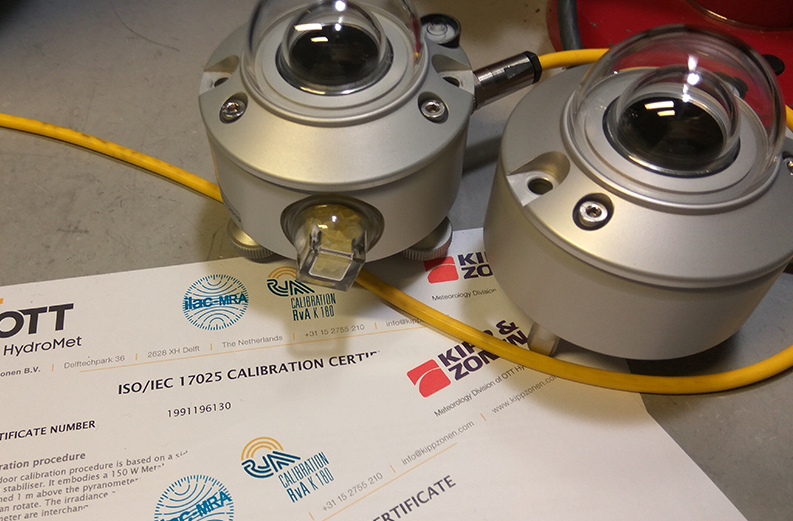All new Kipp & Zonen CMP series, SMP series and CM4 pyranometers ordered from 1st of January 2020, will be supplied with sensitivity calibration certificates carrying the logos related to our accreditation. This also applies to the PR1 pyranometer and PH1 pyrheliometers fitted to the RazON+ all-in-one solar monitoring system and to the CHP1 and SHP1 pyrheliometers normally used with our SOLYS sun trackers.
All the above radiometers can be recalibrated to ISO/IEC 17025 through our Service department when received in Delft from 1st of January 2020. In addition, we can do this for many of our older instruments: CM3, CM6B, CM11B, CM21, CM22 and CH1.
What ISO/IEC 17025 Accreditation Means
The title of the EN ISO/IEC 17025 standard is: “General requirements for the competence of testing and calibration laboratories”. When a laboratory is accredited according to this standard, the management system has been approved, the methods used for calibration are validated, the calibration results have been independently compared to results of other accredited labs and the claimed uncertainties have been verified. Procedures for the entire calibration process are in place, making sure all instruments get a proper, correct calibration and constant quality will be delivered.
Our radiometric calibration laboratory in Delft has been accredited by the Dutch Accreditation Council, “Raad van Accreditatie” (RvA) which is appointed by law as the national accreditation body for the Netherlands and is therefore a member of the European Co-operation for Accreditation (EA). RvA is a co-signatory to both the International Laboratory Accreditation Cooperation (ILAC) for laboratories and inspection bodies and the International Accreditation Forum (IAF) for certification bodies.
Kipp & Zonen sensitivity calibration certificates for the radiometers described above will carry the logos of RvA and ILAC. The scope of our accreditation can be found on the RvA website at https://www.rva.nl/scopes/details/K180
ISO/IEC 17025 Provides Additional Confidence
ISO/IEC 17025 accreditation is the single most important standard for calibration and testing laboratories around the world. The accreditation helps and end-user minimize risk by improving confidence in the irradiance measurements. Many industrial users, including in solar energy, require calibrations of measuring instruments by accredited laboratories. This includes pyranometers and pyrheliometers used for the performance monitoring of solar power plants.
The accreditation has not changed the calibration methods that we use or the uncertainty of the calibrations (see below) but it gives the customer an additional layer of quality assurance.
How We Calibrate
Our pyranometer calibrations for many years have been carried out to the international standard ISO 9847:1992 ‘Calibration of Field Pyranometers by Comparison to a Reference Pyranometer’. We use method IIc, for direct beam indoor calibration, as described in Annex A ‘Calibration Devices Using Artificial Sources’. Our equipment and method are specifically referred to in Annex A.3.1 as the “Kipp & Zonen Device and Procedure”. We have improved this since the original 1992 description.
ISO 9847 requires that reference pyranometers are calibrated outdoors to ISO 9846:1993 by comparison to a reference pyrheliometer for direct radiation and a reference shaded pyranometer for diffuse radiation. The global radiation is calculated form these values and the solar zenith angle, and we do this using the alternating sun-and-shade method.
We calibrate pyrheliometers using our own indoor procedure that has been developed and refined over many years. The Accreditation Council has determined that this is a valid and accurate method.
All our pyranometer and pyrheliometer calibrations are traceable to the World Radiometric Reference (WRR) which represents the SI units of irradiance and itself has an uncertainty of ± 0.3% at the 95% confidence. The WRR is located at the World Radiation Centre (WRC) in Davos, Switzerland and WRC is operated by the Physikalisch-Meteorologisches Observatorium Davos (PMOD) by appointment of the World Meteorological Organisation (WMO).
Not All Accredited Laboratories Are The Same
One of the most important parameters on any ISO/IEC 17025 accreditation certificate is the Calibration and Measurement Capability (CMC) at the 95% coverage / confidence level. This is the best calibration uncertainty that can be achieved, and it varies from laboratory to laboratory depending upon the processes and traceability used.
Kipp & Zonen is accredited for sensitivity calibration with excellent CMC values of 0.9% for pyranometers and 1.1% for pyrheliometers. The individual calibration uncertainty depends upon the model of radiometer and its performance characteristics, but the accredited CMC’s demonstrate the high quality of our methods and procedures.
